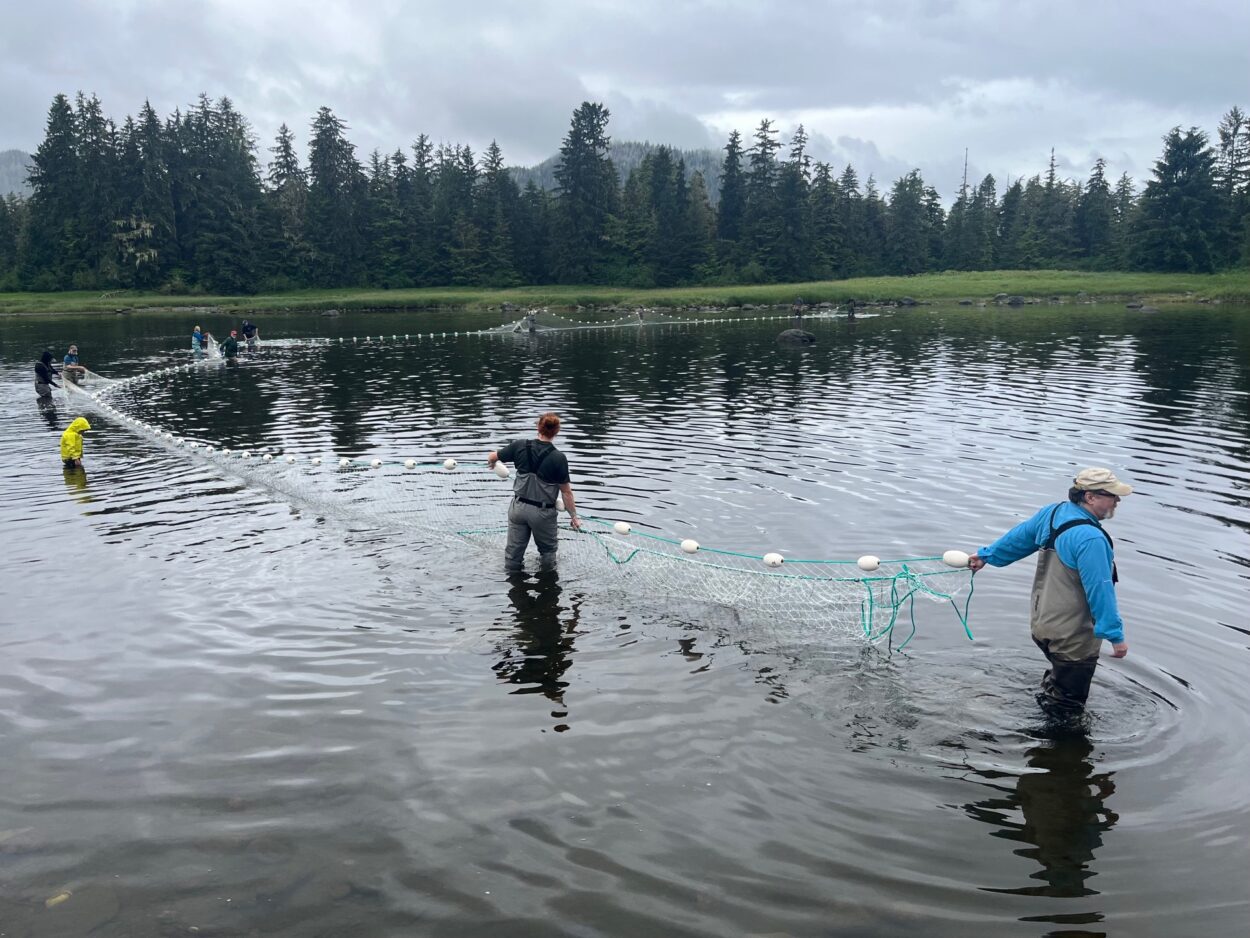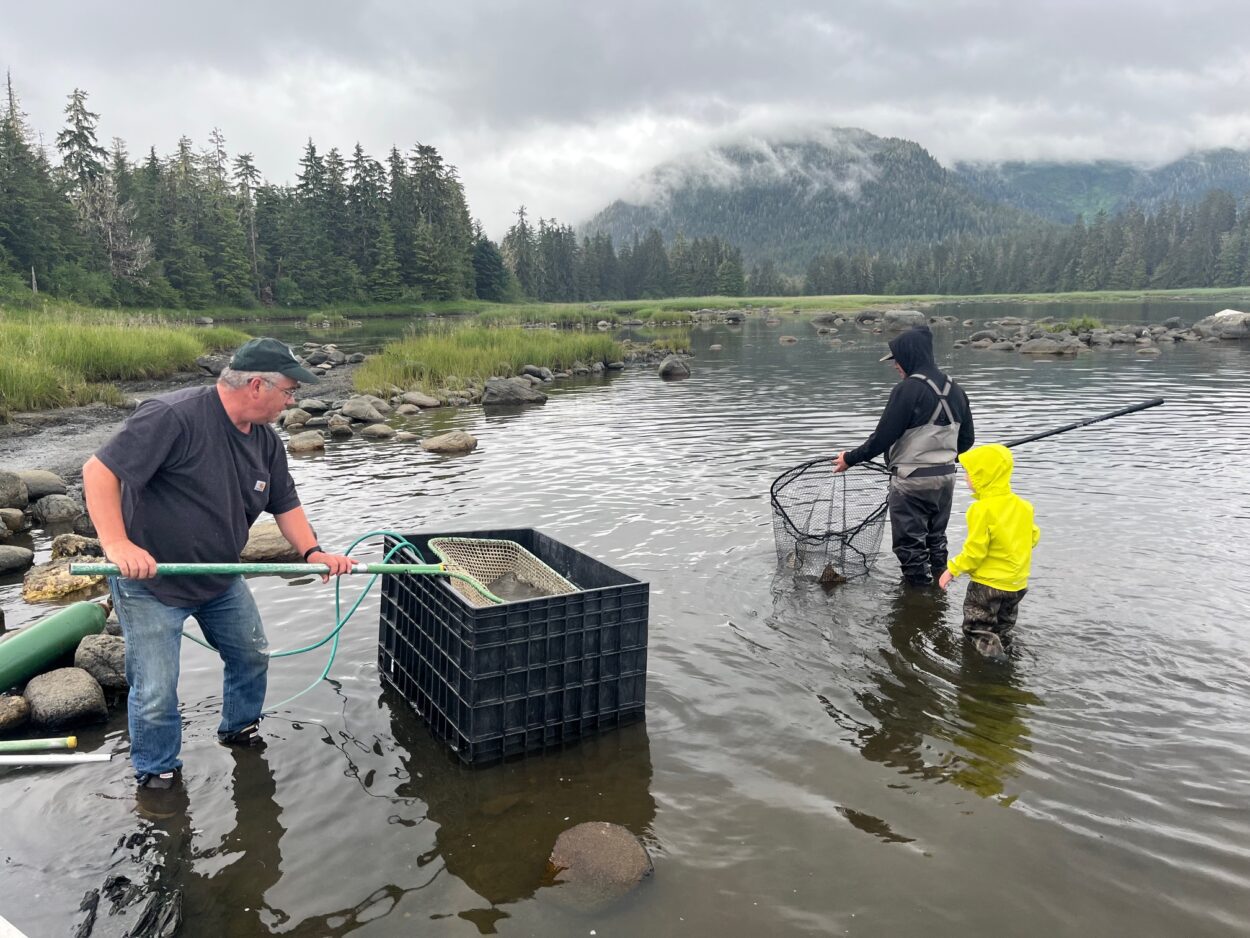
The king salmon at Blind River Rapids weren’t in a hurry to head upstream. It was mid July, and they were hanging out in the clear, rocky waters of the rapids, their bodies slowly preparing to spawn.
Earlier in the year low projected returns triggered a closure of the popular freshwater sport fishery that targets the kings, inspiring managers to give the fish some unconventional help.
The assistance came in the form of hatchery workers, biologists, and volunteers, who milled about on the shore, waiting to help some king salmon take the long way home – using four-wheelers.
“We just finally got to the point where we figured we had to try something,” said Bill Gass, who was calling the shots at the rapids. He’s with the Southern Southeast Regional Aquaculture Association, a group that manages the 50-year-old Crystal Lake hatchery as well as others in the region.
The plan was to scoop the fish out of the water, put them in totes, haul the totes to the 4-wheeler, drive it up the quarter mile boardwalk to the road where a bigger tote is waiting, which, once full, will be trucked up the highway to Crystal Lake Hatchery where the salmon would “ripen” for a few weeks before they spawned.
That was the plan. It would be the first time they’d tried it.
They had decided to give it a shot because each year the hatchery needs a certain number of returning salmon to create the next king salmon runs. Those returning salmon are called broodstock in the industry. The hatchery hadn’t met its broodstock goals in two out of the last 10 years. This year, projected returns are low.
Gass said management discussed the possibility of the salmon shuttling for decades. However, the experiment was risky. Fish get stressed out when they’re handled a lot like they would be when they’re caught and then moved from tote to tote. That stress could affect their egg viability, or even kill them.
So, why can’t the fish get themselves to the hatchery? According to Gass, it’s an unusual place.
“It’s all these fish can do to stay alive,” he said. “The last stretch is where it’s really challenging, it’s often six inches deep. So they sit there and cook and struggle.”
The salmon have to swim up an intertidal slough that becomes rapids in some places. It’s shallow and rocky, especially when there’s little rain or the tides are low. That makes it hard for salmon to swim through, which means it heats up quickly. King salmon don’t do well with heat. According to state biologist Patrick Fowler, they can tolerate heat for a period of time.
“Then there is the red line where, if it gets warm, and we have a lot of fish in a small space, but not a lot of water coming – that’s often what kills them,” he said.
The kings tend to hang out in the rapids for several weeks. If there’s rain and high tides during that time, the salmon stand a good chance of making it to the hatchery. Some years, though, tides are low, and the weather’s warm, and Blind River Rapids is littered with rotting salmon carcasses. While that’s good for scavenging eagles and bears, it’s hard for the hatchery to meet its broodstock goals.
So, is this problem due to climate change? Fowler said there’s not enough data to know.
“We don’t have great temperature records, you know, going back in the length of time that would need to know, specifically for Blind Slough,” he said. “We know we’ve had die-off events in blind slough decades ago.”
He said while it’s not a new issue, warmer waters in the slough will add to the problem.
“I don’t see the problem getting better into the future! I’d probably phrase it that way,” he said.
According to Rick Fritsch with the National Weather Service, warmer air temperatures are a predictor of warmer water. He said data strongly suggests that 15 miles north in Petersburg, average July temperatures increased significantly in the 50 years since the hatchery was built.

At the Blind River Rapids, Fowler helped organize volunteers. He stood on the shore, totes of nets and buoys nearby.
“Who here has waders that want to get in the water?” he asked.
Six people raised their hands.
He laid out the plan.
“So we have two 300-foot nets,” he said.”The idea is we’re going to put this one on the downstream, basically, from here to that point of land, to keep them from running down.”
Some volunteers splashed out into the waste-deep water, pulling the net along. More volunteers ventured upstream with the second net, boxing in the fish. The corralled fish were easily scooped up with a dip net, and then, one by one, walked towards a holding tote in the shallows.
From there they got rushed – very gently – to a tote on wheels on shore, which was pulled up to the waiting four-wheeler once it held two or three fish.
The kings were chauffeured up the boardwalk slowly, to minimize jostling.
At the highway, volunteers helped dump them into a bigger tote. Once it held about a dozen fish, it got trucked a few miles to the hatchery.
Gass peered into the depths of the holding tote.
“So, they still swimming?” he asked.
“Oh, they’re doing great now,” the volunteer told him.
“Oh good, that’s what I was hoping to see!” he said, grinning.
By midafternoon that day, the team had moved 64 fish to the hatchery and not a single one had died. The next week, they did it all over again. This time they moved 82 fish and had one mortality. They’d planned on a third day, but there were high tides coming and heavy rain in the forecast, so they decided to call it quits.
While they still needed more than 1,000 fish to make it up to the hatchery the old- fashioned way, Gass said he was pretty pleased.
Still, I had to ask – “Why is all this effort worth it?!”
Gass laughed.
“People love their king salmon,” he said. “And you know, this is the only way to keep things going. We’ve got to have eggs. We’ve got to get these fish to the hatchery.”
The effort was a test of concept, he said. Now they’ll track the eggs of the transported salmon to see how successful they are and what the survival ratio is.
Gass said they’ll know more in mid-August, once hatchery workers start the spawning process – that’s where they fertilize fish eggs by hand.











